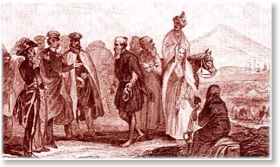DIASPORAS, LANGUAGE &
CULTURE
Historical
Background of Armenian Diasporan Communities




Language & Culture in Diasporan Communities:




Today, the Armenian diasporan tradition continues. Unlike voluntary migrations that are often a quest for better economic opportunities, Armenian diasporas, historically, were a matter of survival. Currently, the narrative of the Armenian Genocide is almost limited to the loss of 1.5 million Armenians. Sadly, this narrative often ignores the larger consequence of the event. The crime, perpetrated by the Turks in 1915, created the largest Armenian Diaspora, dispersed around the world. For most Armenians living in these diasporas who are born under different skies, Historical Armenia is not a place but a point of reference. In the absence of the place and in order to maintain the point of reference alive, Armenian language is one of the important ingredients.
It is a struggle to maintain the collective memory of a nation. However, throughout their 4 millennia history, the struggle to survive has always been a second nature to Armenians!
I am always sorry when any language is lost,
because languages are the pedigrees of nations.
Samuel
Johnson